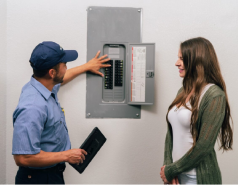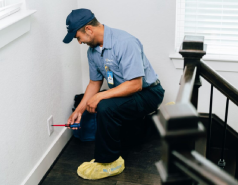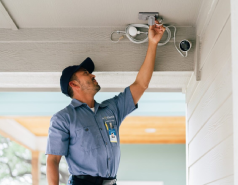Safety outlets are designed to prevent electrical hazards by responding to potentially dangerous conditions, such as moisture, electrical arcing, or contact with foreign objects. They are a proactive way to reduce the risks associated with electricity—particularly in areas that are exposed to water or where children are present.
There are several types of safety outlets available, each offering different forms of protection:
AFCI Outlets
Arc fault circuit interrupter (AFCI) outlets help prevent electrical fires by detecting arcing conditions in your wiring. Arcing occurs when damaged or loose wires cause electricity to jump across a gap, which can generate intense heat. When AFCI outlets detect these faults, they immediately shut off power to stop the flow of electricity and reduce the risk of a fire. These outlets are especially important in bedrooms, living rooms, and other areas where frequent appliance or electronics use is common.
GFCI Outlets
Ground fault circuit interrupter (GFCI) receptacles are essential in rooms or areas where outlets are exposed to moisture. These outlets constantly monitor the electrical current that is flowing in and out of the circuit. If an imbalance is detected—such as an event where electricity is traveling through water or a person—the outlet cuts power instantly. GFCI devices are a requirement of building codes in rooms including kitchens, bathrooms, laundry areas, garages, basements, and outdoors.
Outdoor Outlets
Outdoor electrical outlets must withstand exposure to the elements. They are typically installed with weather-resistant covers and often incorporate GFCI protection to meet code requirements. Outdoor electrical outlets provide convenient access to power for landscaping tools, holiday lighting, outdoor furniture, and more. If your exterior outlets lack protection or are outdated, upgrading to safe, outdoor-ready options is essential.
Tamper-Resistant or Childproof Outlets
Tamper-resistant outlets are necessary in any home or other structure that has children. These outlets are designed with internal spring-loaded shutters that prevent objects from being inserted unless equal pressure is applied to the two slots at the same time, as with a standard plug. This design greatly reduces the risk of electric shock from foreign objects and is now required in new residential construction.













